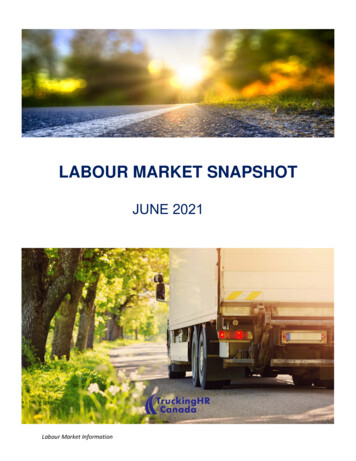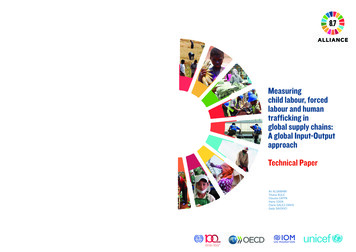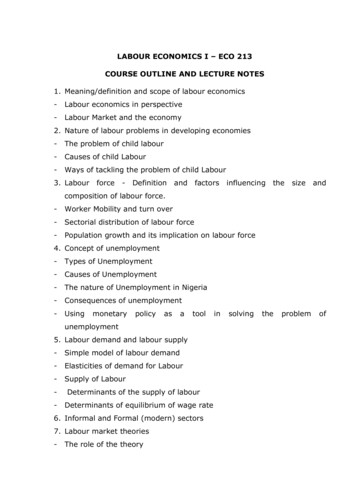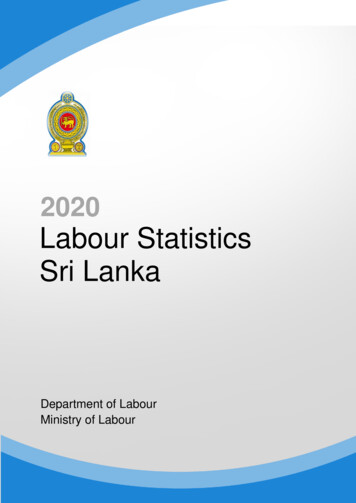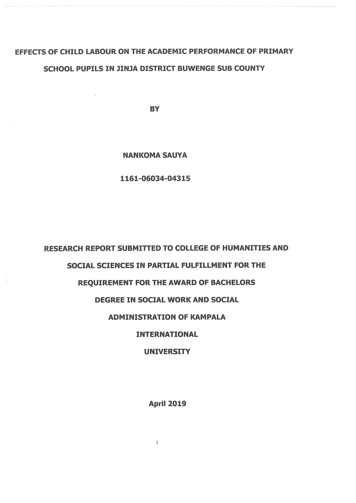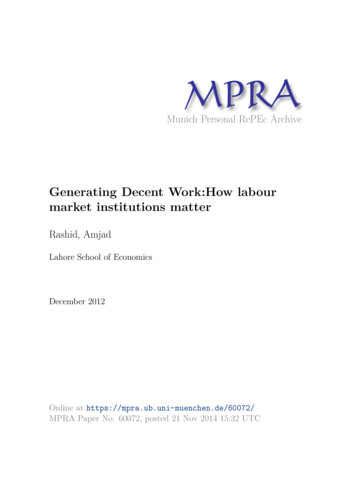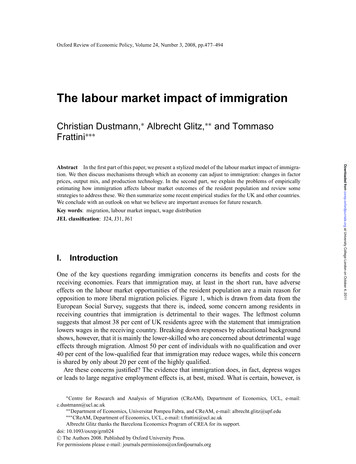
Transcription
Oxford Review of Economic Policy, Volume 24, Number 3, 2008, pp.477–494The labour market impact of immigrationChristian Dustmann, Albrecht Glitz, and TommasoFrattini I. IntroductionOne of the key questions regarding immigration concerns its benefits and costs for thereceiving economies. Fears that immigration may, at least in the short run, have adverseeffects on the labour market opportunities of the resident population are a main reason foropposition to more liberal migration policies. Figure 1, which is drawn from data from theEuropean Social Survey, suggests that there is, indeed, some concern among residents inreceiving countries that immigration is detrimental to their wages. The leftmost columnsuggests that almost 38 per cent of UK residents agree with the statement that immigrationlowers wages in the receiving country. Breaking down responses by educational backgroundshows, however, that it is mainly the lower-skilled who are concerned about detrimental wageeffects through migration. Almost 50 per cent of individuals with no qualification and over40 per cent of the low-qualified fear that immigration may reduce wages, while this concernis shared by only about 20 per cent of the highly qualified.Are these concerns justified? The evidence that immigration does, in fact, depress wagesor leads to large negative employment effects is, at best, mixed. What is certain, however, is Centre for Research and Analysis of Migration (CReAM), Department of Economics, UCL, e-mail:c.dustmann@ucl.ac.uk Department of Economics, Universitat Pompeu Fabra, and CReAM, e-mail: albrecht.glitz@upf.edu CReAM, Department of Economics, UCL, e-mail: t.frattini@ucl.ac.ukAlbrecht Glitz thanks the Barcelona Economics Program of CREA for its support.doi: 10.1093/oxrep/grn024 C The Authors 2008. Published by Oxford University Press.For permissions please e-mail: journals.permissions@oxfordjournals.orgDownloaded from oxrep.oxfordjournals.org at University College London on October 4, 2011Abstract In the first part of this paper, we present a stylized model of the labour market impact of immigration. We then discuss mechanisms through which an economy can adjust to immigration: changes in factorprices, output mix, and production technology. In the second part, we explain the problems of empiricallyestimating how immigration affects labour market outcomes of the resident population and review somestrategies to address these. We then summarize some recent empirical studies for the UK and other countries.We conclude with an outlook on what we believe are important avenues for future research.Key words: migration, labour market impact, wage distributionJEL classification: J24, J31, J61
478Christian Dustmann, Albrecht Glitz, and Tommaso FrattiniFigure 1: Does immigration lower wages? Answers from the European Social Surveythat wage responses to immigration, if they occur, will not be distributed evenly across thedistribution of resident wages, but will be more pronounced in those parts of the distribution inwhich immigrants compete with native workers. We return to Figure 1 later on, to understandwhether the differential concern across different education groups is justified.In this paper, we briefly review some of the possible mechanisms by which the receivingeconomy may adjust to immigration. The mechanism that has received most attention in theeconomic literature is factor prices, in particular wages. We explain the circumstances underwhich immigration may lead to negative wage effects for the native workforce, whose wageswill be affected, and when adverse effects may or may not occur. But wage adjustments areonly one of many mechanisms by which an economy may react to immigration. We brieflyoutline some important alternative adjustment channels.After setting out the theoretical foundations, in the second part of the paper we turn tothe challenges facing the analyst when attempting to estimate the effects immigration mayhave on wages. Here we discuss in particular problems of identification and how these can besolved.In the third part, we review some recent research, and discuss the evidence on the wageeffect of immigration in the UK and the international context.Downloaded from oxrep.oxfordjournals.org at University College London on October 4, 2011Notes: The figure shows the distribution of answers of UK residents to the question whether immigrants lower wages. The first column reports answers for the whole population, while columns 2–5report distribution of answers by education group. High education: university degree or equivalent orpostgraduate qualification. Intermediate education: A-level, national vocational qualifications level3/5, or equivalent. Low education: GCSE, O-level, CSE, national vocational qualification level 1/2,or equivalent.Source: European Social Survey, first wave, 2002.
The labour market impact of immigration479II. The labour market impact of immigration(i)Adjustment to immigration through wagesWe distinguish between skilled and unskilled workers who may be natives (born in thedestination country) or immigrants (born in a country other than the destination country).Within a particular skill group, immigrants and natives are perfect substitutes, i.e. they areinterchangeable. The third factor of production is capital and we commence by assuming thatcapital supply is perfectly elastic. This means that firms obtain capital at a fixed interest rate,which could be thought of as being set on an international market. Finally, we assume thatboth skilled and unskilled labour supply is perfectly inelastic. This means that workers willchoose to work at any wage. Again, we relax this assumption later on.WagesSuppose now that, before immigration occurs, the economy consists of skilled and unskilledworkers, say in equal proportions, and is in labour market equilibrium in the sense that allworkers are employed at equilibrium wages, which may vary by skill level. If the newlyarriving immigrants differ in their skill endowments from native workers, they will inducea change in the overall skill composition in the economy. For instance, if all immigrantsare unskilled, then this will lead to a disequilibrium between supply of and cost-minimizingdemand for different labour types at existing wages and output levels. There will be an excesssupply of unskilled workers at the going wage rate. Absorption of these new workers intoDownloaded from oxrep.oxfordjournals.org at University College London on October 4, 2011We commence by discussing the possible mechanisms by which immigration may impact onwages of the receiving country’s population. We start with the simplest possible economicmodel, where wages are determined by the country’s production technology, as well as supplyof production factors. We assume that the potential immigration country has only one industryand produces only one output good, using both labour and capital.The first question that arises is how immigrants enter this model. Some early papersassume that immigrants are a distinct factor of production, i.e. labour consists of immigrantsand natives (see, for example, Grossman, 1982), and that immigrants and natives are notperfectly substitutable. However, it seems quite difficult to argue that two equally qualifiedworkers, one a native and the other an immigrant, are not easily substitutable in production. Itseems more reasonable to draw a distinction between different groups of labour inputs alongthe skill dimension.Therefore, later papers have chosen a production technology that distinguishes betweenskilled and unskilled labour, and assumes that immigrants are perfect substitutes with theircorresponding native skill category. How skills are defined in detail varies by study, but typicaldimensions are educational attainment (e.g. Altonji and Card, 1991; Dustmann et al., 2005),occupation (e.g. Card, 2001), or experience and education (e.g. Borjas, 2003; Aydemir andBorjas, 2007). We start by exploring the economic consequences and predictions of a modelof this type.More recently, some papers have gone a step further and relaxed the assumption of perfectsubstitutability of immigrants and natives within pre-defined skill categories using nestedproduction technologies (see, for example, Ottaviano and Peri, 2006, and Manacorda et al.,2006). We briefly discuss this later.
480Christian Dustmann, Albrecht Glitz, and Tommaso FrattiniFigure 2: Wage effects of unskilled immigrationWagesunskilledSDS’Immigration surplusMAw0Cw1BMarginal productof unskilledlabour0NN MEmployment unskilledthe economy and restoration of equilibrium will therefore almost certainly involve short-runchanges in wages and employment levels of different skill types.A first key observation in this set-up is, therefore, that immigration only affects wages (andpossibly employment rates) of resident workers if the skill distribution of immigrants differsfrom that of the native workforce. Only in that case will their inflow lead to changes in therelative supply of different skill groups and thus to a disequilibrium in the labour market ofthe host economy. If the skill distribution of immigrants is equal to that of natives and capitalsupply is fully elastic, then immigration will simply lead to an increase in the scale of theeconomy through an increase in output with no effect on wages and employment of natives.For illustration, we consider the extreme case where all immigrants are unskilled. Immigration will now lead to an excess supply of unskilled labour at the pre-immigration wages.Because unskilled labour is in excess supply, firms will be able to satisfy their demand forlabour even at lower wages. This leads to a decrease in wages of unskilled workers which, inturn, increases demand, until all unskilled workers (immigrants and natives) are employed,but at a lower wage than the pre-immigration wage.Accordingly, unskilled native workers lose as a consequence of immigration. However,a supply shock of unskilled workers leads to a relative scarcity of skilled workers in oureconomy, driving up their wages. Skilled workers therefore enjoy a gain from immigration.While wages of unskilled workers fall, wages of skilled workers rise. In our simple economy,the surplus accruing to skilled workers will be higher than the loss to unskilled workers(with the difference often referred to as the ‘immigration surplus’). We have demonstratedthis in Figure 2, concentrating on unskilled workers only. The vertical axis shows wagesand the horizontal axis employment. In the pre-migration period, all native workers N areemployed at wages w0 , and the pre-migration equilibrium is at point A. Immigration ofsize M leads to a shift in the (perfectly inelastic) labour supply schedule. As skilled labourremains constant, this leads to a relative excess supply of unskilled labour, thus driving wagesdown the marginal product curve D. The new equilibrium is at point B, where wages haveDownloaded from oxrep.oxfordjournals.org at University College London on October 4, 2011D
The labour market impact of immigration481EmploymentOne assumption we make above is that workers supply labour whatever the wage—we refer tothat situation as one where labour supply is completely inelastic. If labour supply is somewhatelastic, then some workers will not want to work if wages are decreasing, and rather chooseunemployment. In this situation, there are equilibrium employment effects. Immigration maycause (voluntary) unemployment among native workers whose wages fall. We illustrate thisin Figure 3. Here the labour supply curve is upward sloping, and an increase in labour supplythrough migration leads to some native workers no longer being prepared to work at the new,lower equilibrium wage. These workers (given by N0 – N1 in Figure 3) remain, therefore,voluntarily unemployed. In this situation, the total output share that goes to unskilled workershas decreased by the dark diagonally striped area. It now falls partly to skilled workers (thearea of the rectangle w0 –A–C–w1 ), and partly to the immigrants (the area of the rectangleD–C–N0 –N1 ). The immigrant surplus, which again also falls to skilled native workers, is inDownloaded from oxrep.oxfordjournals.org at University College London on October 4, 2011decreased to w1 . In this new situation, the total output share that goes to unskilled workershas decreased by an amount reflected by the area of the rectangle w0 – A – C – w1 . This shareof output falls now to skilled labour. As all unskilled workers including immigrants workat a wage that is equal to the marginal product of the last immigrant, immigrants create anadditional surplus, which is given by the triangle ABC and which also falls to skilled nativeworkers.It seems that our simple model suggests that immigration has, in the worst case, no effecton average wages. How does that square up with the common perception that immigration isbad for wages on average? Remember that we made a key assumption, namely that capitalis elastic in supply. This seems to us a reasonable assumption for small open economiessuch as the UK, and for migrations of the magnitude we usually observe. If we give upthis assumption, then re-distribution will be not only to skilled labour but also to capital,and average wages (not only wages of the unskilled) may decrease as a consequence ofimmigration. Thus, which effects on average wages we expect within this simplest possiblesetting depends on the view we take about capital mobility.There is little empirical evidence on how capital flows actually respond to immigrantinflows. In their analysis on the wage impact of immigration in the USA, Ottaviano andPeri (2006) explicitly take capital adjustments into account and estimate the speed at whichcapital reacts to deviations from its balanced growth path. Consistent with the evidence fromthe growth and business-cycle literature (Islam, 1995; Caselli et al., 1996; Romer, 2006),they find a convergence rate of 10 per cent per year (so that each year 10 per cent of theimmigrant-induced deviation from the balanced growth path of the capital/labour ratio iseliminated by capital inflows), which they point out is likely to be a conservative estimate ofthe yearly speed of capital adjustment, in particular for open economies. In their example,this adjustment speed means that, instead of reducing the capital/labour ratio by 11 percent and consequently average real wages by 3.6 per cent, the immigrant inflows to theUSA between 1990 and 2004 only reduced the capital/labour ratio by 3.4 per cent, whichin turn implies a much smaller negative effect of only 1.1 per cent on average wages in theeconomy. Basically, the faster capital is able to adjust, the smaller will be the effect on averagewages in the economy. More direct evidence linking capital flows directly to immigration isneeded. Dependent on the features of the destination country and the length of period understudy, the assumption of elastic capital supply seems not unreasonable. On the other hand,the assumption of perfectly inelastic capital supply, which is implicitly often made in thisliterature, seems too strong to us.
482Christian Dustmann, Albrecht Glitz, and Tommaso FrattiniFigure 3: Employment effects of unskilled immigrationWagesunskilledSDS’Marginal productof unskilled labourAw0Dw1CB0N1 N0N 1 MEmployment unskilledthis case given by the triangle A–B–C and is smaller than it would have been in the case ofperfectly inelastic labour supply.(ii) Alternative adjustment mechanismsThe economy we have characterized above is a one-sector economy, where only one outputgood is produced. Such an economy can only react to a change in the composition of itsworkforce (e.g. due to immigration) through changes in the wage structure. This is clearlya strong simplification—economies are characterized by a multitude of different sectors,producing goods that differ in their capital intensity and in their relative use of skilled versusunskilled labour. This complexity gives rise to two alternative adjustment mechanisms, whichwe briefly discuss in the next section.Output mixThe first mechanism is reflected in the mix of output goods the economy produces. Suppose,as before, that immigrants increase the relative supply of unskilled versus skilled workers.While in our simple model above the absorption of the additional supply of unskilled workerscomes about through a decline in unskilled wages, with more than one industry there isan additional way of accommodating the increase in unskilled labour supply: by increasingproduction of those output goods that use unskilled labour more intensively (Rybczynski,1955). The idea here is the following (see Gaston and Nelson, 2000, for a more detaileddescription): suppose the immigrant-receiving country is a small open economy consisting oftwo industries which each produce an output good that is traded on the world market. Assume,further, that one of the industries is intensive in the use of unskilled labour while the other isintensive in the use of skilled labour. As long as the output produced in our economy relativeto the overall world production of the goods is small, the small open-economy assumptionDownloaded from oxrep.oxfordjournals.org at University College London on October 4, 2011D
The labour market impact of immigration483TechnologyThere is a second adjustment mechanism to immigration. This mechanism works throughtechnology. The idea is again simple, and can be most easily understood by inspecting theproduction of goods in different countries. Agricultural production of goods that are tradedin international markets, such as rice, differ substantially in their labour intensity betweencountries of the developing world, where unskilled labour is abundant, and countries of thedeveloped world, where unskilled labour is in relatively lower supply. There is a pool ofproduction technologies available to produce the same output good. Suppose, as before, thatthere are two different industries which both produce an output good with a given technologyand relative factor intensity. Immigration now leads again to an increase in the relativesupply of unskilled workers. Faced with this change in labour supply, both industries nowendogenously select a production technology out of the pool of available technologies thatis more intensive in the use of unskilled labour. By changing production technologies, theeconomy will, in this case, be able to absorb the additional supply of unskilled labour withoutnecessarily significant changes in the local wage structure or the local output mix. Recentempirical evidence that on-the-job computer use as well as automation expand most rapidlyin those areas where the relative supply of skilled labour grows fastest, points towards theimportance of this adjustment channel (Lewis, 2005; Beaudry et al., 2006; Doms and Lewis,2006).A number of papers analyse empirically which of the two channels, changes in output mixor changes in production technology, is quantitatively more important in absorbing changes inlocal labour supply (Hanson and Slaughter, 2002; Lewis, 2004; González and Ortega, 2007;Dustmann and Glitz, 2008). The overwhelming evidence from these studies shows that theDownloaded from oxrep.oxfordjournals.org at University College London on October 4, 2011implies that prices for both goods can be assumed as fixed on the world market. In such aneconomy, the increase in unskilled labour supply induced by an immigrant inflow will nowinitially drive down wages of unskilled workers (and increase wages of skilled workers) asin the previous example. However, this change in relative wages now leads to a relativelylarger decrease in unit production costs for the low-skill-intensive industry than for theskill-intensive industry. With output prices fixed, there will be larger profits in the low-skillintensive industry. In a perfectly competitive market these profits then induce new firms toenter the industry (or firms to move from the skill-intensive to the more profitable low-skillintensive industry), expanding its production and increasing the relative demand for lowskilled workers. This, in turn, will drive up unskilled wages. Accordingly, while the immediateimpact of immigration is to lower wages of unskilled workers, in the longer run wages willincrease again. Assuming the eventual equilibrium continues to involve positive productionin all traded goods sectors, wages should return to the initial pre-immigration equilibrium.However, the adjustment process may be very quick, for instance if firms foresee the changein skill composition, or if the required capital for the expanding industries is easily available.Leamer and Levinsohn (1995) refer to this as the hypothesis of factor price insensitivity. As aresult, the economy will fully absorb the additional unskilled workers through an increase inthe production of that good that uses unskilled workers more intensively without long-termchanges in the relative wage structure. These results can be generalized to multiple inputfactors and multiple outputs, and can be extended to the case of non-traded goods, with therelevant algebra being detailed in trade theory models (see, for example, Woodland, 1982;Ethier, 1984). The key requirement to allow the economy to react through flexibility in itsoutput mix is that there are more traded goods in the economy than there are factors ofproduction.
484Christian Dustmann, Albrecht Glitz, and Tommaso Frattinibiggest part of the absorption of additional workers, roughly around two-thirds, is explainedby endogenous changes in production technology.(iii) DiscussionDownloaded from oxrep.oxfordjournals.org at University College London on October 4, 2011What do we learn from our above considerations for how we should assess the effects ofimmigration on the labour market, and on wages in particular? First, effects are only to beexpected if immigrants change the skill structure of the receiving country.Second, if that is the case, the effects of immigration are differently felt across the distribution of wages. In particular, it will be those workers who are most similar to immigrants intheir skill composition that may lose, but workers who possess different skills may gain. In thiscontext, a slight modification of the prediction of the distributional impact of immigration isrequired, if immigrants and natives are only imperfect substitutes within the same (observable)skill group (see Ottaviano and Peri, 2006; Manacorda et al., 2006). In that case, an increasein labour supply owing to immigration will primarily affect other immigrants already livingin the host country. Owing to the overall complementarity of immigrants with natives, mostgroups of natives actually experience significant wage gains from immigration, with only thelowest skilled groups actually suffering some relatively mild wage cutbacks. However, owingto their higher substitutability, the detrimental effect from newly arriving immigrants on thewages of existing immigrants that are estimated in these studies is substantial.Third, whether we believe that the overall effects on wages of resident workers (i.e. theeffect on the average native wage in our economy) is positive, zero, or negative, and themagnitude of these effects, depends on our views about the elasticity of capital supply. Ifcapital is supplied perfectly elastically, then migration does have wage effects, but these arenegative for workers who compete with immigrants and positive for workers who do not.Overall, at the margin, the effect on the overall average wages is always zero. Owing to themigration surplus, the average wage effect for natives, however, may even be positive. Thus,migration may in this setting harm some, but it will benefit others (see Dustmann et al., 2008,for more detail).Fourth, there are alternative adjustment mechanisms besides wages that may play animportant part in an economy’s response to immigrant inflows. If we allow for multipleindustries and (some) fixed output prices through, for instance, trade, then migration, evenif changing the skill structure of the economy, may not affect wages at all, but be absorbedthrough changes in the industry structure and the output mix.Fifth, even if the industry structure remains unchanged, an alteration in the skill mix inducedby immigration may be absorbed at constant wages by endogenous changes in productiontechnologies.Accordingly, theory provides us with a multitude of different effects immigration mayhave on the labour market. The key question that arises for particular countries is now howimmigration actually impacts the particular economy in reality. For economists, this translates into the question as to how the effect of immigration on native employment and wagescan be estimated, what the problems of empirical assessment are, and what the empiricalevidence is. Below we discuss these challenges and how they can be addressed. The problemsthat arise in analysis are quite similar whether we wish to investigate the effects immigration may have on wages or, for instance, on the production technology. As the issue mostintensively discussed is wage effects, we illustrate the empirical problems for estimatingthese.
The labour market impact of immigration485III. Measuring the immigrant impact on the labour market (wt 1 wt 1 ) (wt 1 wt 1 ).It 1 It 1 The problem is the hypothetical wage wt 1—which is not observed, as we do not observewages in the hypothetical absence of migration. This number is what we call the missingcounterfactual. In order to obtain an estimate of the effects immigration has on wages, thiscounterfactual has to be re-constructed. In essence, the entire empirical literature on the impactof migration is concerned with re-constructing this missing counterfactual. Re-constructionwill always require some assumptions—we call these assumptions identification assumptions.How credible these identification assumptions are determines how much credibility we shouldgive to the results of empirical work.So how can we re-construct this missing counterfactual? One way to do it is basically toslice the labour market into different sub-markets, and compare wage changes in marketsthat experienced in-migration, and markets that did not. The most common approach in theliterature to achieve this is to distinguish between different regional labour markets.Suppose, for instance, that a receiving country has two regions, the North and the South,and that the North experienced less in-migration than the South in year t. Then one couldutilize the variation in in-migration between the two regions to compute the parameter ofinterest. Using our notation above, and adding to the notation by distinguishing wages in theSouth and North through indices S and N, one could compute S NNS wt 1 wt 1wt 1 wt 1 N NSSIt 1 It 1 It 1 It 1and use this as an estimate of the effect of immigration on wages.There is a remaining problem with this approach: immigrants are typically not randomlyallocated across the regions of the receiving country; they rather choose where to go, and theyare likely to choose that region that experiences the highest wage growth. The immigrationinflow to either region, It 1 It 1 , will thus be determined by the expected increase in wagesin either region, E(wt 1 wt 1 ). Suppose the region with the higher wage growth is theSouth, and that immigrants correctly expect this, leading to a larger inflow into the South. Inthat case, our estimate above would give us a positive number (suggesting that immigrationincreases wages) even if the causal effect of immigration on wages were equal to zero.To circumvent this problem, we can choose different avenues. First, in particular circumstances, it may be that immigrants have no choice of initial settlement, and are allocated toDownloaded from oxrep.oxfordjournals.org at University College London on October 4, 2011To understand what is involved in answering these questions, let us focus on wages, andlet us assume that we have one big immigration wave in one particular year, t. The analystobserves the wage in the economy before migration takes place (year t 1), and the wageafter migration has taken place (year t 1). One way to assess the effect of migration is tocompare average wages in the years t 1 and t 1, wt 1 wt 1 . However, it is obviousthat this will not answer the question as to how migration has impacted on wages of residentworkers because other mechanisms, such as the economic cycle, technology, etc., will alsohave affected wages after migration. What the analyst would want to compare is the wagechange before and after migration, wt 1 wt 1 , (which is observed) with the wage change wt 1 , and to relate thisthat would have taken place had migration not occurred, wt 1to the magnitude of immigration, which could be measured by the change in the stock ofimmigrants, It 1 It 1 . The effect immigration has on native wages is then the parameter
486Christian Dustmann, Albrecht Glitz, and Tommaso FrattiniDownloaded from oxrep.oxfordjournals.org at University College London on October 4, 2011particular areas. This is, for instance, the case with immigrant dispersal policies in Sweden(Edin et al., 2003) and Denmark (Damm, 2006). These government policies are a sourceof exogenous regional allocation of immigrants by assigning them to particular local labourmarket upon arrival and in that way preventing the immigrants from endogenously movingto those areas that offer the most favourable labour market conditions. For Germany, Glitz(2006) takes advantage of a similar policy in which a particular group of immigrants, socalled ethnic German immigrants, were exogenously allocated to specific regions by the authorities, based on fixed quotas, in order to ensure an even distribution across the country. Aspredicted by the previous example, h
We conclude with an outlook on what we believe are important avenues for future research. Key words: migration, labour market impact, wage distribution . CReAM, Department of Economics, UCL, e-mail: t.frattini@ucl.ac.uk Albrecht Glitz thanks the Barcelona Economics Program of CREA for its support. doi: 10.1093/oxrep/grn024 C The .


